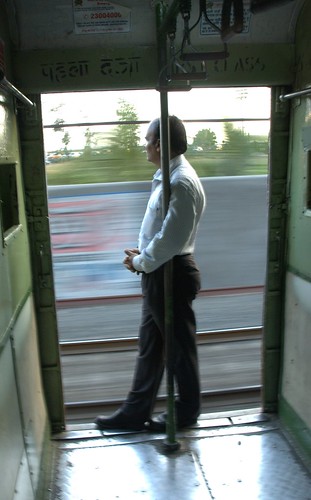You will be familiar with the word ‘Learnability’ had you worked in Infy. It’s otherwise an unknown term. I googled Learnability. All I got were techie results including ‘Why Java Sucks: Notes on Learnability and Ease of Use.’ [A harassed software engineer would have written the article]. Learnability is the ability to learn1. It’s the ability to adapt to new situations2 and the ability to understand the rules of a changing game and excel at them. Learnability is important because it is the single most important factor that determines the pace at which an individual grows. Imagine a graph on which your growth and growth of your peers are plotted on y-axis and time on x. Over time, gap builds between those who grow fast and those who don’t. For those who grow slow, it becomes increasingly difficult to catch up with the those at the front and after a period, impossible. Learnability gives you that ability to grow fast and the ability to scale no matter whether you are trying to scale from being entrepreneur to a CEO of a large company or from being an entry level employee to being a valuable player for a company.
Take a look at Bill Gates’ response to a question from an interview with Prannoy Roy on NDTV:
Sushil Gupta: This question is for Mr. Gates. My question is what is the fundamental difference, if any, between managing a startup and a large corporation like Microsoft?
Bill Gates: I think there is quite a difference in the managerial style and leadership style you need as the company grows large. It is actually very rare, Infosys, Microsoft, and may be three or four other companies had had continuity of leadership even if you have gotten to a very large size. It requires the skill-set of being somebody who loves looking at code, you know sitting down with customers, doing that, and that rarely comes with being somebody who can step back and pick the right people, create a system to monitor those things and really be in much more of a leadership role, and so I had had to learn a lot as the company has gotten bigger.
Source
It’s less obvious that from running a start up to managing a large company, you will see a gradient of skill sets for a number of intermediate roles that Bill Gates had to play. To transition to the next role, you will need new skills. Learnability is this ability to figure out the new skill sets, acquire them and demonstrate the maturity to take up the next role.
The third quality I spoke above has the most impact and is the toughest to acquire. It’s like playing chess. You continuously analyze various players, understand changing rules and excel the new ones or create them. This trait comes to fore when things get into a flux. It could be an acquisition, reorganization, an induction of a new CEO, etc. are all events that give you the opportunity. People who have high learnability quotient are active understanding and turning the rules of the game in their favor.
Allied with this skill is the ability to drop your current toolset. Specially if you are good at it. How many tech geeks continue to invest a lot of time, energy and money to keep pace with technology though it may not add any incremental value? They do it just because it is cool or because it differentiates them. I am not against technology. Why go after it if it does not add additional value? Those with high learnability quotient will be happy to drop their tools3. Take a look at what Mark Shuttleworth has to say.
It’s the ability to learn tools, not the tools themselves
The most successful people learn how to spot the best tools and trends and to take advantage of them. They also learn to LET THEM GO when the time is right. Rather than being convinced your tools are the One True Way, recognize that they are rocking good tools right now and will also certainly be obsolete within five years.
If you don’t drop tools, you might diagnose the problem incorrectly or prescribe incorrect measures. I read in an entrepreneurship related article that entrepreneurs tend to respond from their area of strength. E.g. In response to falling revenues, a marketing manager turned entrepreneur will respond by advertising more, an ex-accountant by cutting costs and an ex-operations manager by making operations more efficient. “If all you have is a hammer, everything looks like a nail.” So true. You have to figure out if you have the right hammer for the nail you have at hand.
Learnability at an organization level
Organizations also have a learnability quotient. It reflects in the pace at which it takes decisions. E.g. Ten years back, there were several technology services companies in India. Very few managed to scale up and excel at new rules. Accenture is a good example. It realized the disruptive nature of Offshore IT services and set up its Indian arm. Hearsay is that they got a few things right. Their Global Delivery Network headcount outside US reached 44,000 in Feb 06 (from 19,000 in May 05) with more than 17,500 in India alone. EDS on the other hand, though it founded the IT services industry, managed to pull together 3,000 people by May 06. The Mphasis acquisition was more desperate than proactive. Its net margin in 1Q FY06 was 24 million on the base of $5 B revenue or net margin of 0.5%. Accenture makes 5% --ten times that of EDS (Wipro makes 24% but the comparison is not apples-to-apples). Recently, EDS divested AT Kearney. So it has two missing pieces in its strategy – a consulting organization and the offshore capability. Accenture which learnt the game ahead has all the pieces – Consulting, IT services, BPO and Offshore capability.
Improving learnability
Getting back to learnability at an individual level, how do you improve leanability? I don’t know. But I reflect on certain traits that people with high level of learnability have. First, these people make the most out of ambiguity. They involve themselves when the rules are still being made and tune them to suit themselves. Second, they are calculative. They think two steps ahead and calculate how changing rules will affect themselves. But it must be possible to learn learnability. :) I read somewhere that JRD Tata learnt music at the age of 80!—a great testimony to his hunger for learning. My father is currently (at the age of retiring) learning music. His teacher is my age! I think I am fortunate to be in that environment. There is no bad age to learn anything. It’s about ‘living in the moment’ and figuring out how things fit in our lives and careers.
Notes:
1. Ability to learn continuously. Because if you do not, by mere passage of time, you will be obsolete. I read somewhere that you tend to forget >80% of what you have learnt in 24 hours. [Revision or repetition is the key to memory… so memory books say]. “What can be learnt can be unlearnt,” said an actor friend of mine. I agree with him, there is little news here. 2. Ability to adapt to new situations. Infy’s version: “We define learnability as the ability to extract generic inferences from specific instances and using them in new, unstructured situations.” This captures the crux of what I want to say.
3. I have some experience in dropping tools. I am good at MS Excel. So much so that I was famous for solving people’s excel problems. Some time, people from a different city called me saying they had an excel problem and needed my assistance. I made some presentations [(a), (b)] too. After a point I realized, excel skills alone gave me little competitive advantage.
Interesting links: Symantec said the rules of security software changed
itheabsolute says Enthropy is manager’s enemy















